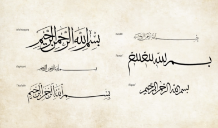By the pen and how they write
The art of Islamic calligraphy had humble beginnings, as the artistic aspect of writing was not a concern for the original Qur’an copyists. Their immediate purpose was to preserve the accuracy of God’s revelations. At the outset, two rudimentary forms of script existed: one was known as Kufic – angled and reserved for writing the Qur’an and important correspondence; the other form was rounded and cursive and was used for secular and day-to-day purposes. From these two forms, many variants emerged, and a system of proportional writing called al-khatt al-mansud was applied to existing cursive scripts known as Aqlam as-sittah.
Writing and copying the Qur’an are considered acts of piety, as well as an opportunity and a challenge to beautify the word of God. When copying the Qur’an, accuracy, legibility and aesthetics all play a role in the calligrapher’s art. The task of writing is done with calligraphic pens (qalam) made from dried hollow reeds. The nib’s width is crucial to the writing, and the calligrapher would cut the nib to achieve the ideal slant for the task. The scripts are written according to precise rules of proportion and require careful calculations. The calligrapher must take into consideration the various ways in which letters are combined, possible arrangements or combinations, the rise and fall of letter forms, optimal spacing for legibility, and optimal ratios between letter height and width.
Since Islamic calligraphy is inextricably linked to the faith, the art form took on a different nuance wherever Islam spread. Muslim calligraphers in China developed Chinese-Arabic calligraphy, also known as sini (Arabic word meaning ‘Chinese’), which is still in use today. It is believed to have originated along the port cities in South China, such as Fuzhou, Quanzhao and Hangzhou, brought in by Arab traders, as early as the seventh century.
In the next section we will go into how sini differs from Arabic calligraphy.

](https://micrio.thingsthattalk.net/DUyAf/views/max/226x128.png)
](https://micrio.thingsthattalk.net/Abvtj/views/max/236x128.png)
, (accessed 10/08/2021)](https://micrio.thingsthattalk.net/fVBRd/views/max/205x128.png)
, (accessed 10/08/2021).](https://micrio.thingsthattalk.net/IAGWq/views/max/183x128.png)